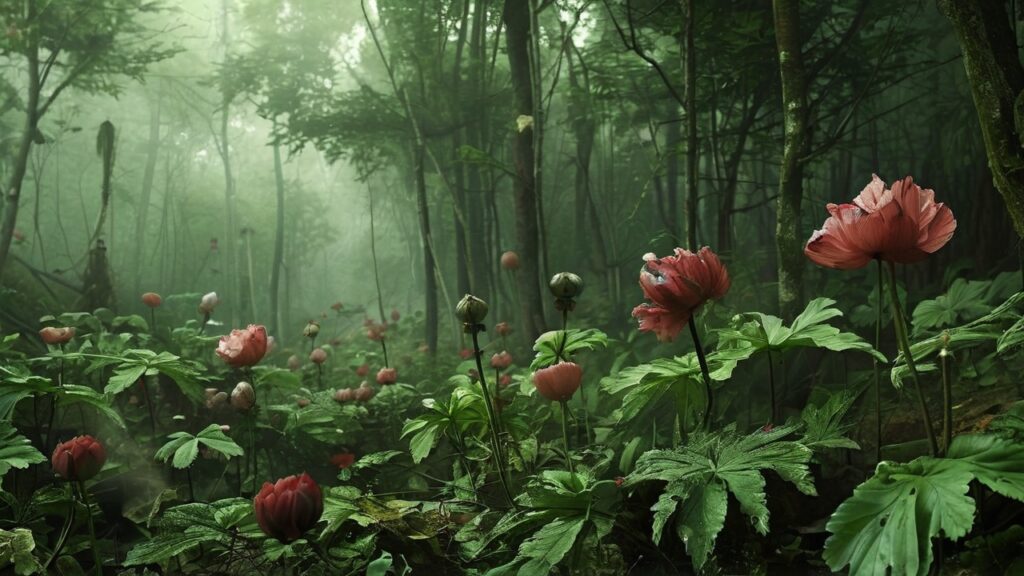Introduction
Poppy is extracted from the unripe seed capsules which grow on the cultivated plants. In India, poppy is grown
When the seed capsules are unripe they are slit to extract latex. This concentrated latex is collected and dried and is sold as poppy, which is used for medicinal purposes.
Chemical Composition
Its seeds contain light yellow coloured, sweet oil which is known as rogan khash-khash. It contains morphine, narcotene and codene. In addition it contains many primary and secondary carbonic acid, lactic acid and meconic acid like organic acids, resin, glucose, fat and
Properties
Its seeds taste bitter and addictive; it also creates vata. It cures cough and bronchial asthma. It dries up the constituent elements of the body, is highly intoxicating,makes one talkative. Its continued use can cause impotency.
Opium is addictive and drains energy, it creates aste and pilte and has the same properties as the pod. Poppy seed improves potency, promotes physical strength, is hard to digest, and increases kapós and sula.

Uses :
ficadache: Grind 1 gm poppy with 2 cloves and apply on the forehead. It cures headache due to acidity, gastric disorders or due to chill and cold.
Eye disorders: Its paste is beneficial in curing eye pain and other disorders of eyes.
Nasal bleeding: Grind poppy and gum of kundra in equal quantities. Give this to the patient, paste to be inhaled. It cures nasal bleeding,
Hair: Grind its seeds in milk and apply the paste on the head. It cures boils and ulcers in head and also cures dandruff.
Tooth ache: Mix 16 mg poppy and 125 mg nansadar. Keep this powder in the aching tooth. It cures the tooth ache. When placed in the cavity of tooth, it gives relief from tooth ache.
Ear pain: Mix 65 mg ash of poppy with rose oil and put a few drops in ears. It cures ear pain.
Throat voice problem: Boil poppy pods with Ajowan and give this to the patient for gargles. It cures hoarse voice
1. Botanical Features:
- Appearance: The opium poppy plant can grow up to 1 to 5 feet tall. It has smooth, blue-green leaves and large, showy flowers that can range in color from white to red, purple, or pink.
- Seed Pods: After the flowers bloom, they produce a seed pod. When these pods are lacerated, they exude a milky latex, which contains the opiates.
- Opiate Content: The sap from the poppy contains alkaloids, notably morphine, codeine, and thebaine. These compounds are highly active biologically and are the foundation of several potent medications.
2. Historical Use:
- Ancient Use: The use of the opium poppy dates back thousands of years. Ancient civilizations, such as the Sumerians (around 3400 BCE), referred to the plant as the “joy plant” and utilized it for medicinal and recreational purposes. The Egyptians, Greeks, and Romans also used opium as a sedative and to treat various ailments.
- Opium Wars: In the 19th century, the opium trade between British merchants and China led to the infamous Opium Wars (1839–1842 and 1856–1860), which had significant political and economic impacts, particularly for China, leading to the Treaty of Nanking.
3. Medicinal Use:
- Opium in Medicine: Opium and its derivatives, including morphine and codeine, have long been used as powerful analgesics (pain relievers). Morphine, extracted from the opium poppy, is still used in modern medicine for pain management, especially in terminal illnesses and after surgery.
- Development of Heroin: In the 19th century, chemists isolated morphine from opium and later synthesized heroin, which was initially marketed as a less addictive alternative to morphine, though it proved to be even more addictive.
4. Illicit Use and Addiction:
- Opium Derivatives: Opium can be processed into heroin, an illicit drug with devastating effects on human health and societies. The plant is grown extensively in regions like Afghanistan, where it is a significant cash crop in the illegal drug trade.
- Addiction Crisis: The opioid crisis in various parts of the world, especially in the United States, is partly attributed to the over-prescription of opioid medications derived from the opium poppy, leading to widespread addiction.
5. Cultural and Religious Significance:
- Symbolism: Throughout history, the opium poppy has been a symbol of sleep, peace, and death. In Greco-Roman mythology, the poppy was associated with Hypnos, the god of sleep, and Thanatos, the god of death.
- Modern Symbol: In many Western countries, red poppies are worn on Remembrance Day to honor soldiers who died in war, inspired by the poem “In Flanders Fields,” which references poppies growing in the battlefields of World War I.
6. Current Legal Status:
- Controlled Substance: While cultivation of the opium poppy for the purpose of producing drugs is illegal in many countries, the plant itself is not always outlawed. In some places, poppy seeds are used legally in cooking and baking (the seeds themselves contain very little, if any, opiate content).
- Pharmaceutical Use: The pharmaceutical industry tightly regulates and controls the production of opium derivatives, which are used in a controlled manner for pain management.
7. Agricultural Practices:
- Growing Regions: The opium poppy is mainly grown in Southeast Asia, Central Asia, the Middle East, and Latin America. The Golden Triangle (Laos, Thailand, and Myanmar) and the Golden Crescent (Iran, Afghanistan, and Pakistan) are two regions famous for large-scale illegal opium production.
- Legal Cultivation: Some countries like India and Turkey have government-controlled, legal cultivation of opium poppy for medical purposes.
